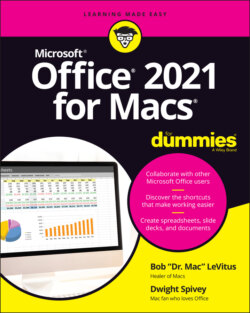Читать книгу Office 2021 for Macs For Dummies - Bob LeVitus - Страница 23
Using Menus in Office Apps
ОглавлениеEach Office app has around a dozen menus in its menu bar. Some, such as the Apple, File, Edit, View, Window, and Help menus, are mostly the same as their namesakes in other Office programs (and macOS) and contain the usual commands. Others, such as the Format, Tools, and Insert (Word, Excel, and PowerPoint) menus, offer different options in different programs. And some menus, such as Word’s Table menu, Excel’s Data menu, and PowerPoint’s Arrange and Slide Show menus, are exclusive to a particular app.
We discuss many of the commands on these menus throughout the rest of this book; in this chapter, we cover some general information about using commands and features that are mostly the same in all Office apps.
First, although many menu commands work only after you’ve selected (highlighted) some text or another object, a number of menu commands don’t require text selection. For example, all items on the View menu work, regardless of whether text is selected when you choose them. Many items on the Insert menu operate based on the location of the insertion point in your document and, in fact, blow away any text that’s selected when you choose them.
Be careful about selecting text. Although many commands require you to select text first, other commands replace the selected text with something completely different. For example, if you choose Insert ⇒ Chart (or one of many other items on the Insert menu) while text is selected, the selected text is replaced by the chart. (Chapter 5 covers text selection in more detail.)
Fortunately, the Office apps let you perform an almost unlimited number of undo actions, so you can undo what you did even after you’ve performed other actions in the meantime. Just choose Edit ⇒ Undo as many times as necessary to restore the text you just replaced. It wouldn’t hurt to memorize its keyboard shortcut, ⌘ +Z. By the way, this shortcut for Undo works in almost every program on your Mac.
Another thing to know about Office app menus is that an item that ends with an ellipsis ( … ) opens a dialog rather than performs an action immediately. Nothing happens unless or until you click OK or another action button. When you click OK, the appropriate action is performed either on the selected text, at the insertion point, or to the entire document, depending on the menu command.
If you accidentally choose a menu item that opens a dialog, either click the Cancel button or press the Esc key on your keyboard to dismiss the dialog without making any changes to your document.
An arrow on the right side of a menu item, such as the ones next to Insert, Delete, and Select on Word’s Table menu, shown in Figure 3-1, means that you see a submenu when you select that item.
FIGURE 3-1: An arrow indicates that a menu item has a submenu; dimmed text indicates that an item isn’t available now.
When an item on a menu is dimmed, such as Split Table, Merge Cells, and Split Cells on the Table menu (refer to Figure 3-1), you can’t select the item because that command isn’t available at this time.
Why would an item be unavailable? In Figure 3-1, the items that are dimmed are available only when you’ve placed a table in your document and either the table is selected or the insertion point is somewhere in the table.
If you see a dimmed menu command, look at your document and ask yourself why it’s dim. Usually, the answer is a logical one, such as the command works only on a table or requires a text selection.
